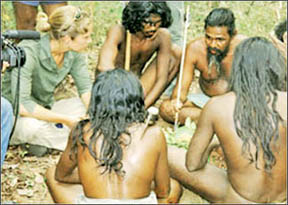World must save them from extinction threat
Today, we celebrate the international day of the
world’s indigenous people:
|

The voices of Indigenous peoples, if we take the trouble to
listen to them, convey priceless messages to the world: their
traditions, particularly ethical and spiritual ones, coupled
with their management of complex ecosystems and their know-how,
all play a vital role in the search for development and peace.
Safeguarding their cultures and acknowledging their rights are
of strategic importance for the future of humankind. |
PEOPLE’S RIGHTS: In 1994, the General Assembly decided that the
International Day of the World’s Indigenous People shall be observed on
August 9, every year during the International Decade of the World’s
Indigenous People (resolution 49/214 of 23 December).
The date marks the day of the first meeting, in 1982, of the Working
Group on Indigenous Populations of the Subcommission on the Promotion
and Protection of Human Rights.
In 1990, the General Assembly proclaimed 1993 the International Year
of the World’s Indigenous People, and in 1993, the Assembly proclaimed
the International Decade of the World’s Indigenous People, starting on
10 December 1994.
The goal of the Decade was to strengthen international cooperation
for solving problems faced by indigenous people in such areas as human
rights, the environment, development, education and health.
The Coordinator of the Decade was the Office of the High Commissioner
for Human Rights; and its theme “Indigenous people: Partnership in
action”.
UNESCO states that Indigenous populations number some 350 million
individuals in more than 70 countries in the world, and that this
represents more than 5000 languages and cultures. Today, many Indigenous
peoples live on the fringes of society and are deprived of basic human
rights, particularly cultural rights, due to dispossession and
displacement from their land.
An Indigenous person is, by definition, a person belonging to the
land or soil and being native to, or belonging naturally to a particular
region.
Indigenous identity and cultural expression is closely linked to
their relationship with land areas.
It is essential to know and understand the deeply spiritual special
relationship between Indigenous peoples and their land as basic to their
existence as such and to all their beliefs, customs, traditions and
culture... Their land is not a commodity which can be acquired, but a
material element to be enjoyed freely.
It is a day to celebrate the richness of cultural diversity in our
world.
It is also a day to be reminded of the insecure situation in which
many indigenous peoples still have to survive day by day.
It is about recognising the inextricable link between environmental
and cultural diversity. In fact, people are integral parts of
ecosystems. Indigenous peoples often inhabit many of our planet’s areas
of highest biological diversity.
Not only animal and plant species, but also many indigenous peoples’
groups around the world are now faced with extinction. The unsustainable
exploitation of our earth’s natural resources and marginalisation and
dispossession of the lands and territories of indigenous peoples and
minority groups are both cause and consequence of this loss.
Respect for human diversity implies respect for diversity in nature.
Indeed, both elements are fundamental to stability and durable peace on
earth. The key to creating forms of development that are sustainable and
in harmony with the needs and aspirations of each culture implies
breaking out of patterns that render invisible the lives and
perspectives of indigenous cultures.
The environment should be appreciated in terms of human diversity,
because different cultures perceive the environment in different ways.
This sensitive relationship was recognized in Chapter 26 of Agenda 21
which identifies a variety of ways that indigenous peoples, national
governments, and United Nations’ agencies can strengthen the role of
indigenous communities in sustainable development.
Agenda 21 specifies that “in view of the interrelationship between
the natural environment and its sustainable development and the
cultural, social, economic, and physical well-being of indigenous
people, national and international efforts to implement environmentally
sound and sustainable development should recognise, accommodate, promote
and strengthen the role of indigenous people and their communities.”
Agenda 21 also indicates that the international community’s strong
interest in these issues led to the designation of 1993 as The
International Year for the World’s Indigenous People.
The rights of indigenous peoples are also noteworthy in the context
of The Convention on Biological Diversity which recognizes some rights
in principle but leaves much unresolved as to the extent of those rights
in practice.
The potentially high economic value of pharmaceuticals derived from
medicinal plants used by indigenous peoples stimulates interest in the
issue.
Indigenous people have seen decimation of their populations as well
as oppression by the dominant culture, especially in respect of
languages, traditional knowledge and customs.
The programme of activities for the International Decade of the
World’s Indigenous People recognises the value and diversity of the
cultures of Indigenous communities and of their specific forms of social
organisation, and attaches value to the contributions that they can make
to humanity.
The mapping of Indigenous cultural resources carried out by
Indigenous communities is seen as a crucial step toward demonstrating
that cultural diversity is a means of enrichment for the greater
society.
As such, UNESCO continues to support pilot projects at work in the
field.
Projects operating around the globe create numerous opportunities for
interactions between knowledgeable people, Indigenous and non-Indigenous
peoples.
Training and consultation activities in this area also benefit some
of the most marginalised communities.
One of the reasons indigeous cultures have survived for so long is
their ability to adapt and change over time.
It was this affinity with their surroundings that goes a long way to
explaining how they survived for so many millennia.
Today, Indigenous communities keep their cultural heritage alive by
passing their knowledge, arts, rituals and performances from one
generation to another, speaking and teaching languages, and protecting
cultural property and sacred and significant sites and objects. |

